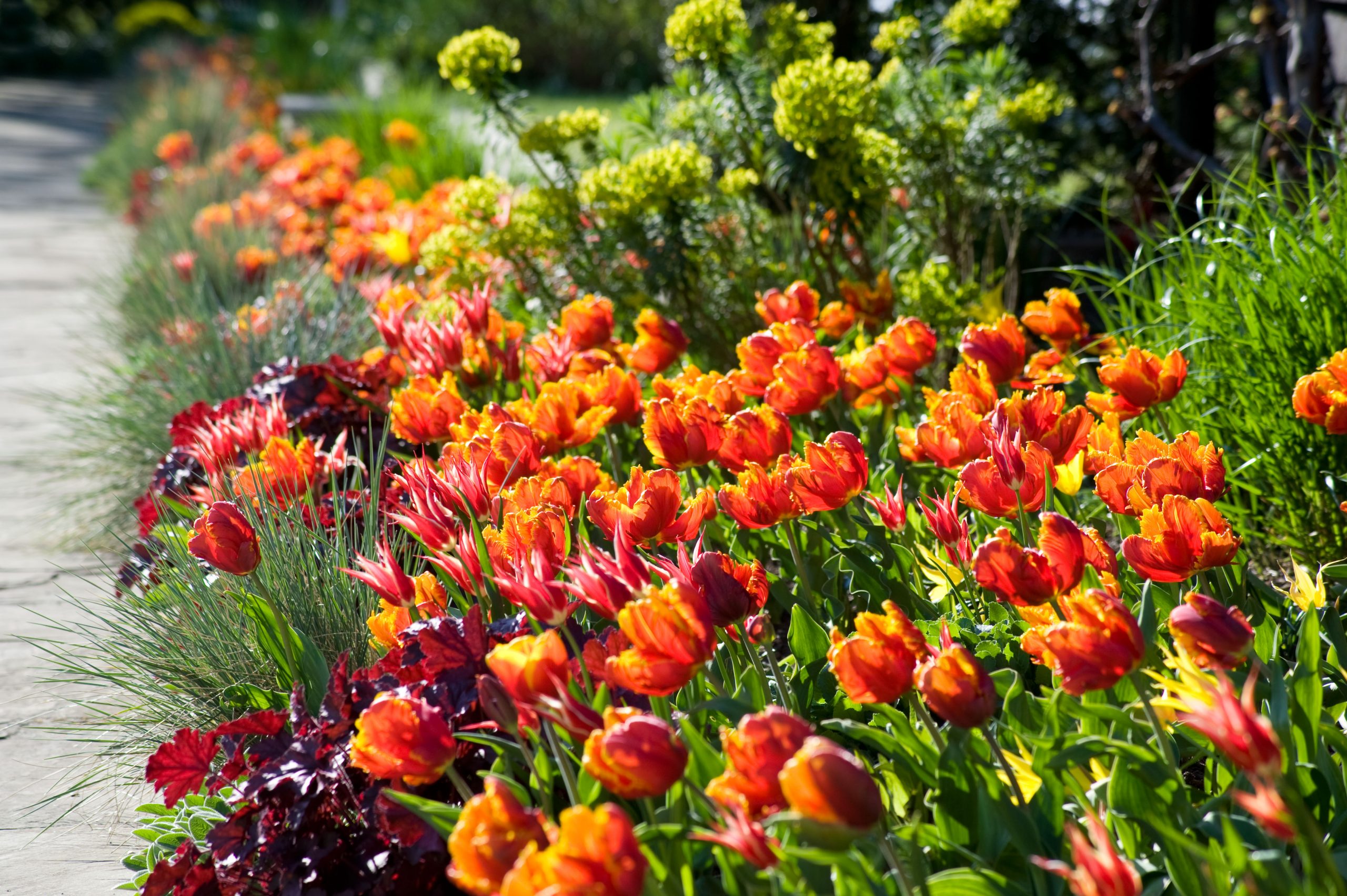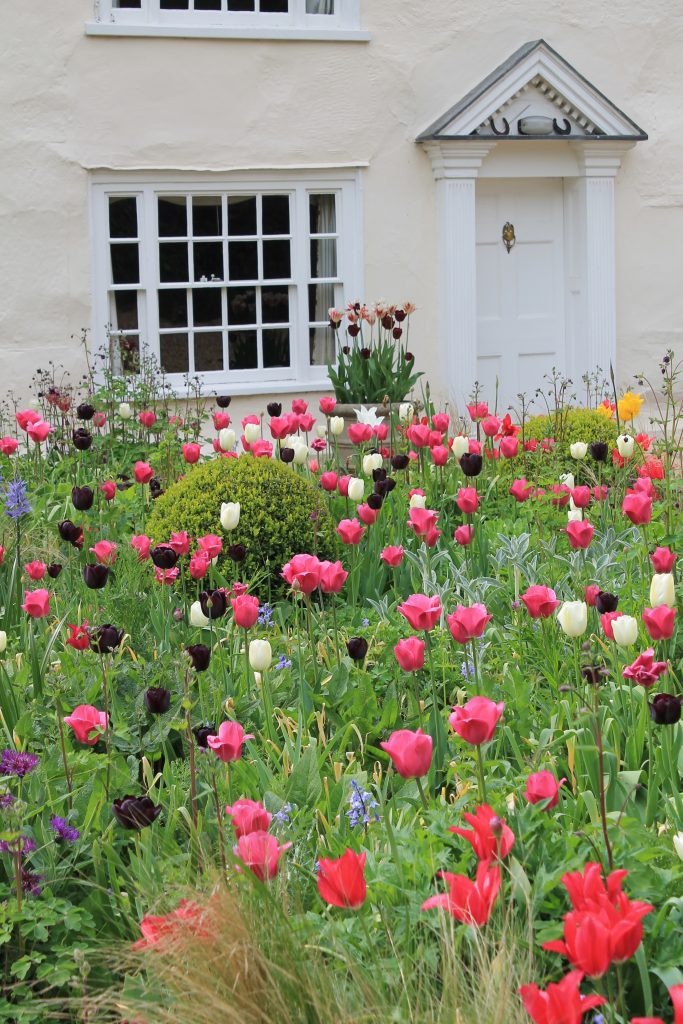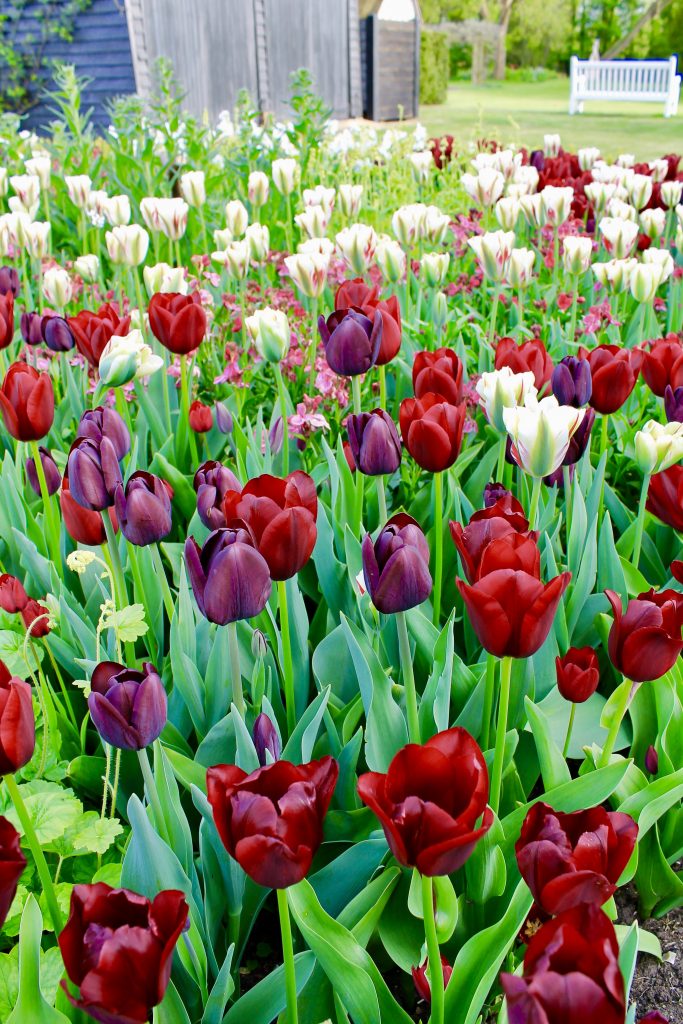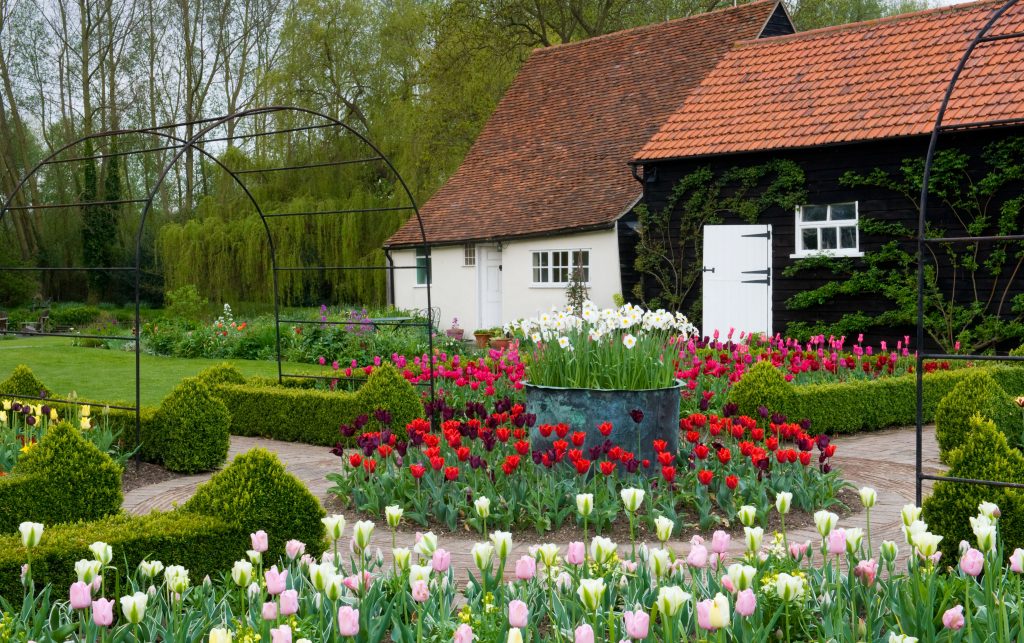Plant in November to get the best out of your bulbs; the tulip bible with Philippa Burrough

The reputation of Philippa Burrough’s stunning Essex garden grows from year to year; recently it was voted one of the country’s top 100 gardens to visit by Garden News magazine. Hardly surprising giving the ravishing plant combinations she arranges in the different beds and borders which have the mellow house and farm buildings as their picturesque backdrop. In the spring it is the stunning display of tulips that attract all the attention with the listed black barns enclosing a stunning display in the old farmyard that is colour coordinated, skilfully mixed with perennials and neatly enclosed with low clipped hedging.
But preparing for this spring showcase means getting to work now, ordering early and planting out in November through to January. Here, Philippa shares her expert advice on getting the best out of your bulbs.
Tulips
Over the years I have lost count of how many tulips I have ordered but as we usually plant around 10,000 each year, I have gleaned a few pearls of wisdom about planting these spring delights. So here are a few tips from our experience at Ulting Wick.
Ordering, and storage
Do it early to ensure you get what you want. Some varieties sell out fast such as on trend “Belle Epoque”. Order from a specialist company to get top size bulbs known as 10/12 or 12+ as they result in the biggest flowers. Smaller, cheap bulbs will have small flowers or none at all.
Ask your specialist supplier to store the bulbs until you need them. I don’t get my tulips delivered until the first week in November. That way they are kept in optimum conditions until they need to be planted. Tulips appear in the garden centres from mid summer and this is too early to buy.
If storing at home before planting then take them out of the packaging and place then in a dark cool airy place in a single layer and watch out for mice who love to nibble away at the bulbs if given the opportunity.
Which tulips to order
There has to be a tulip for everyone. I personally prefer the Lily, Triumph, and late single flowering tulips as the former are so elegant whilst the late flowering ones are tall, robust and their colours sing out in the gorgeous late April /May light. Consideration should be given not just to the flower colour but also the stem colour and leaves. Some tulips like Barcelona have beautiful purple blushed stems and some leaves can be variegated. Also think about the size of the tulip leaves – some can be very fleshy. The lily flowered ones tend to have elegant leaves that combine well with perennials and grasses in a mixed border: we like to plant Ballerina through Carex buchannii. Do think about the emerging perennial and shrub foliage and the colour of the tulips that might suit. I have a particular love of combining Tellima Grandiflora with tulips as the acid green foliage is such a good foil to the vibrant tulip colours.
- Photo: Marcus Harpur
Planting time
Wait until the soil has cooled, ideally after the first frost. This helps slow down the spread of viruses (according to the RHS there are 12 different ones) and botrytis which causes the dreaded “Tulip Fire”. We generally start in mid November and plant up until the end of January. The tulips are fine to be planted this late.
Numbers
The more the merrier. Tulips to make an impact need to be planted in high numbers. If dotted around they get lost and it looks “mean”. In a mass planting then budget for 75 to 100 bulbs per square metre. If planting in pots then a stand of pots will make more of an impact. If threading through a border then the perennial planting will determine where you can plant but do always plant in large numbers to provide a blaze of colour.
How to Plant
Tulips prefer well drained soil, planted in full sun. If you have heavy soil then add sand and gravel into the planting area to assist with potential water logging. Generally plant tulips 8 inches deep or more if possible.
How you plant depends also upon the type of area you are planning:
– If in a row for say cutting, then you can dig a trench and place them in that at a depth 8 inches and back fill the area dug.
– If planting en mass then we find using a long handled bulb planter and working as a pair makes light work of numbers. We lay the tulips out on the bed and then one person makes the hole whist the other pops in a pinch of bone meal and drops the tulip into the hole. We can manage about 1,500 in a day doing it this way.
– When threading tulips through a border we tend to use a hand trowel as the long handled one will inevitably slice through other bulbs already in the ground.
– In other areas where we tend to use them as an “annual” we plant these less deep, say 4 inches which makes removal easier at the end of the season.
– In pots we plant the tulips close together, leaving about 2cm between them at a depth of at least 6 inches. The pots have been cleaned and sterilised before use and we use regular peat free compost with added John Innis plus a little grit mixed in.
Feeding
We use a sprinkling of bone meal below every bulb to promote good root growth and flower formation. We get through a huge tub every year.
Removing Tulips
We dig up a large number of tulips each year and have found that the best time to do this is immediately after they have finished flowering. Just ease the bulb out with a fork holding on to the stem. If left any longer the stem will snap off from the bulb making it more troublesome to remove the bulb in one piece. In dry Essex we have to sometimes water in order to make lifting easier as in dry conditions the tulips are difficult to remove altogether!
Deadheading tulips
We make sure we sweep through all the borders where the tulips are left from year to year and deadhead them all thereby ensuring that the bulbs energy is not spent on making seed.
Pests
 We have muntjac around us that love to graze on the tulips especially when they emerge early in spring. To stop them destroying our displays we net whole beds or we use chicken wire cages placed over a group of cages of the stream bed. These stay on until just before our open days as the by that stage the vegetation has grown enough elsewhere in the garden for the deer to munch on and the perennials around the plants deters them. They will come and take the odd flower but a sprinkling of chilli powder through the borders is enough to put the deer off! Squirrels are less of a problem here but if you are plagued with them then again chicken wire is your friend for pots where you can place a piece over the top of the pot.
We have muntjac around us that love to graze on the tulips especially when they emerge early in spring. To stop them destroying our displays we net whole beds or we use chicken wire cages placed over a group of cages of the stream bed. These stay on until just before our open days as the by that stage the vegetation has grown enough elsewhere in the garden for the deer to munch on and the perennials around the plants deters them. They will come and take the odd flower but a sprinkling of chilli powder through the borders is enough to put the deer off! Squirrels are less of a problem here but if you are plagued with them then again chicken wire is your friend for pots where you can place a piece over the top of the pot.
Tulip Fire and Virus
If you are unfortunate enough to get trouble with viruses then remove all the tulips and rest the ground for a minimum of 3 years.
Tulips are such a glorious sight planted en masse and herald the start of proper spring for me: the variety of shapes and colours are a joy to behold. So be bold and plant lots this autumn. Happy planting.
Enjoy a virtual visit to Philippa’s stunning garden
This lovely film was made during lockdown in 2020 and shows just what can be achieved if you follow Philippa’s advice …
Ulting Wick plans to open again for the National Garden Scheme in 2025 – for more details check the garden listing here





















